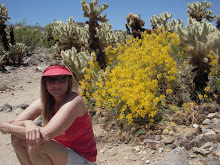 (Cholla Garden)
(Cholla Garden)


 (photos, Joshua Tree National Park, March 2008)
(photos, Joshua Tree National Park, March 2008)
A place to share the sights, history, events, and people of the desert--families, tourists, artists, and wanderers. One day, when you stop on a desert road, get out of your car, walk around and experience the landscape up close. The desert will get under your skin. Maybe into your soul...


 (a blooming yucca; me and a flowering Joshua tree)
(a blooming yucca; me and a flowering Joshua tree)


 Last Saturday while William and I were hiking in Joshua Tree National Park across the road from the White Tank area I came upon this tiny cactus tucked beside an outcropping of rock.
Last Saturday while William and I were hiking in Joshua Tree National Park across the road from the White Tank area I came upon this tiny cactus tucked beside an outcropping of rock.






 Check out Part I of this post if you missed it...
Check out Part I of this post if you missed it...

 A few weeks back I was invited by my friend Ruth Nolan, an English professor at College of the Desert, to attend a poetry workshop at Boyd Deep Canyon Research Center in Palm Desert.
A few weeks back I was invited by my friend Ruth Nolan, an English professor at College of the Desert, to attend a poetry workshop at Boyd Deep Canyon Research Center in Palm Desert. I've never been to this art festival , but I hear great things about it. The festival has been going on for 26 years, and is consistently rated in the Top 10 of art festivals in the country. 250 artists exhibit and sell their work. Attendees are welcome to talk to the artists and learn about their craft and process. Art pieces range in price from $50-$50,000 dollars. (You might want to bring that stash of pennies...)
I've never been to this art festival , but I hear great things about it. The festival has been going on for 26 years, and is consistently rated in the Top 10 of art festivals in the country. 250 artists exhibit and sell their work. Attendees are welcome to talk to the artists and learn about their craft and process. Art pieces range in price from $50-$50,000 dollars. (You might want to bring that stash of pennies...) (photo: Joshua Tree National Park, 2000)
(photo: Joshua Tree National Park, 2000)